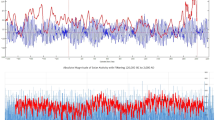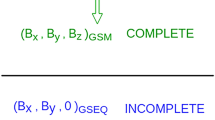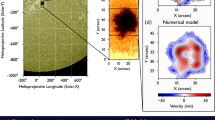Abstract
Cowling1 long ago suggested the presence of a relict field in the Sun's core and argued that the bulk electrical conductivity was sufficient (provided that the field was dipolar) to prevent decay over the lifetime of the Solar System. Evidence for such a field is obtained by inference from the asymmetry in time of the solar sunspot number taken over many cycles2. As the Sun's dipole field reverses polarity approximately every 11 yr, if a core field of odd multipolarity (presumably dipolar) is present and in reasonable alignment with the oscillating dipole of the convective zone, it follows that in successive 11-yr periods, the two fields will tend first to be additive and then subtractive3,4. Because the net dipole field is the ‘seed’ field from which the much larger toroidal field arises5, the latter will vary in magnitude in alternating half cycles and correspondingly mediate the level of sunspot activity. Whether a fossil or relict field is present can be explored either by a search for the presence of a 22-yr line quintet in the Fourier spectrum of the sunspot index2, or alternatively the time sequence itself can be processed so as directly to bring out evidence for an offset. The latter involves a ‘demodulation’ of the sunspot sequence to emphasize the basic 22-yr Hale cycle. The latter is discussed here, but as the two are interrelated, the former is reviewed briefly first to provide the basis for the subsequent least squares (LS) analysis of the demodulated signal. As the solar cycle is unstable to drifts in frequency, the presence of frequency modulation can lead to a spurious relict field signal. A short summary of limits on frequency modulation (FM) contamination of the sunspot index spectrum is also given.
This is a preview of subscription content, access via your institution
Access options
Subscribe to this journal
Receive 51 print issues and online access
$199.00 per year
only $3.90 per issue
Buy this article
- Purchase on Springer Link
- Instant access to full article PDF
Prices may be subject to local taxes which are calculated during checkout
Similar content being viewed by others
References
Cowling, T. G. Mon. Not. R. astr. Soc. 105, 167–174 (1945).
Sonett, C. P. Geophys. Res. Lett. 9, 1313–1316 (1982) in Weather and Climate Responses to Solar Variations, 607 (ed. McCormac, B. M.) (Colorado Associated University Press, 1983).
Levy, E. H. & Boyer, D. Astrophys. J. Lett. 254, L19 (1982).
Boyer, D. & Levy, E. H. Astrophys. J.(in the press).
Parker, E. N. Astrophys. J. 156, (1970).
Box, G. E. P & Jenkins, G. M. Time Series Analysis 2nd edn (Holden-Day, San Francisco, 1976).
Ulrych, T. J. & Bishop, T. N. J. geophys. Res. 13, 183 (1974).
Dicke, R. H. Nature 276, 676 (1978).
Sonett, C. P. J. geophys. Res. 88, 3225 (1983).
Eddy, J. A. in The Ancient Sun(eds Pepin, R. O. Eddy, J. A. & Merrill, R. B.) (Pergamon, Oxford, 1980).
Levy, E. H. & Sonett, C. P. in Protostars and Planets, 516 (ed. Gehrels, T.) (University of Arizona Press, 1978).
Smythe, W. R. Static and Dynamic Electricity 3rd edn (McGraw-Hill, New York, 1968).
Sonett, C. P., Mihalov, J. D. & Ness, N. F. J. geophys. Res. 76, 5172 (1971).
Gough, D. O. Nature 298, 350–354 (1982); Nature 298, 334–339 (1982).
Gilliland, R. L. Astrophys. J. 248, 1144 (1981).
Parkinson, J. H. Nature 304, 518 (1983).
Sofia, S., Dunham, D. W., Dunham, J. B. & Fiala, A. D. Nature 304, 522 (1983).
Isaak, G. R. Nature 296, 130–131 (1982).
Dicke, R. H. A Rev. Astr. Astrophys. 8, 297–328 (1970).
Vitinskii, Yu. I. Preprint, Academy of Sciences, USSR, Leningrad (1962) (translated by Israel Program for Scientific Translation, Jerusalem (1965) [NASA TTF-289]).
Author information
Authors and Affiliations
Rights and permissions
About this article
Cite this article
Sonett, C. Sunspot index infers a small relict magnetic field in the Sun's core. Nature 306, 670–673 (1983). https://doi.org/10.1038/306670a0
Received:
Accepted:
Issue Date:
DOI: https://doi.org/10.1038/306670a0
This article is cited by
-
A nonlinear RLC solar cycle model
Solar Physics (1996)
-
Period and phase of the 88-year solar cycle and the Maunder minimum: Evidence for a chaotic sun
Solar Physics (1990)
-
Solar physics: What causes the solar cycle?
Nature (1986)
-
Secular change in solar activity derived from ancient varves and the sunspot index
Nature (1986)
-
On the R z -sunspot relative number variations
Solar Physics (1985)
Comments
By submitting a comment you agree to abide by our Terms and Community Guidelines. If you find something abusive or that does not comply with our terms or guidelines please flag it as inappropriate.



